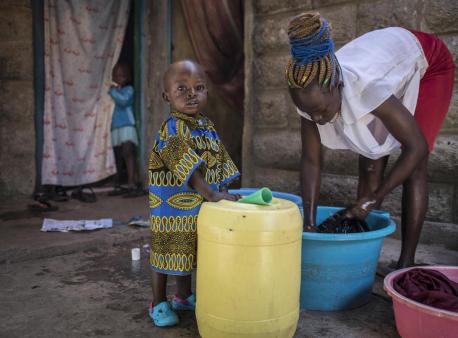
Sanitation Is More Than Just Toilets
Every day, more than 800 children die from preventable diseases caused by poor water quality and a lack of access to adequate sanitation and hygiene facilities. An estimated 4.2 million people around the world live without access to safely managed sanitation.
As a part of the United Nations’ Sustainable Development Goals, the organization commits to achieving basic sanitation for all by 2030. UNICEF works with partners in more than 100 countries to improve water and sanitation services, as well as basic hygiene practices. Sanitation is more than just toilets — it is a comprehensive cross-cutting combination of behaviors and facilities joined together to reduce human exposure to diseases by providing availability of — and access to — a clean and healthy environment. Last year, UNICEF’s efforts provided nearly 14 million people with safe water and over 11 million with basic toilets.

The installation of safe and efficient toilets can be a matter of life and death in places like Nairobi, Kenya, where the sewer infrastructure was originally designed to support 800,000 people. The city's population now exceeds 4 million — some 80% of households in the city do not have access to sewer lines.
In Mukura kwa Ruben, an informal settlement on the outskirts of Nairobi, Josephine Lea Muhonja, 45, and her grandson, 10-year-old Moses (above), are proud of their new pipeless Fresh Life toilet, installed by Sanergy, a company that provides sewerless sanitation solutions.
If this toilet wasn't here, it would be difficult for myself and my family to live here. — Josephine Lea Muhonja, Nairobi, Kenya
“If this toilet wasn't here, it would be difficult for myself and my family to live here,” says Muhonja. “Sanitation has been a big issue [for my community]. In the past, many people would get sick from water-borne diseases, but since the installation of toilets that are well maintained, cleaned and emptied regularly, things have gotten much better.”

The high-quality toilets have a urine-diverting squat plate, making it easy to source-separate solid and liquid waste for daily collection. Above, Wiseman Jirungu, 26, a Sanergy sanitation employee, collects waste from, and cleans, Fresh Life toilets in Mukuru kwa Ruben. The waste is taken to a centralized facility where it is converted into valuable end-products such as organic fertilizer and insect-based animal feed. “I am happy to know that my work makes a difference and that it can improve people's lives here,” he says.

The most effective way of reducing preventable disease transmission caused by contaminated drinking water supply and poor sanitation is through providing clean toilet facilities and promoting handwashing with soap. Constructing sanitation facilities can prevent the spread of disease by flies and the contamination of drinking water, fields and living areas. Above, children use a tank-based handwashing station in Kibera, the biggest informal settlement in Nairobi.

Above, children drink water while having breakfast in their home in Kibera. Though an improved water purification and piping system has been installed in recent years by residents of Kibera, not all families have access to it, and the community still lacks access to a proper sewage system.
Today, an estimated 2.4 billion people worldwide are living without improved sanitation, and 663 million lack access to improved water sources. Until these basic needs are met, the lives of millions of children remain at risk.
Your generous contribution will help UNICEF provide the water, sanitation and hygiene services children need to grow and thrive. Please donate.
Top photo: Cinderella Akinyi Othiambo, 22, washes clothes with a little help from her one-and-a-half-year-old nephew, Duncan, outside her home in Mathare, an informal settlement in Nairobi, Kenya. All photos © Siegfried Modola for UNICEF
HOW TO HELP
There are many ways to make a difference
War, famine, poverty, natural disasters — threats to the world's children keep coming. But UNICEF won't stop working to keep children healthy and safe.
UNICEF works in over 190 countries and territories — more places than any other children's organization. UNICEF has the world's largest humanitarian warehouse and, when disaster strikes, can get supplies almost anywhere within 72 hours. Constantly innovating, always advocating for a better world for children, UNICEF works to ensure that every child can grow up healthy, educated, protected and respected.
Would you like to help give all children the opportunity to reach their full potential? There are many ways to get involved.



